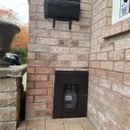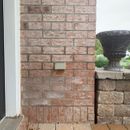Wet spot on bricks and mortar
Hello,
Hope anyone can help us. I have attached a few photos regarding our issue. We have wet brick and mortar approx 3 to 4 feet from our cement foundation in our entry door. It does not rain under that section as it is covered. This issue is worst when it rains and during morning dew. We changed our roof, seal all windows, basement has been verified and there are no leaks or dampness. Also, the interior wall in that section is not wet and there is no water pipes of any kind passing through. Weep holes are fine, gutters verified and we checked and filled out any mortar cracks and holes. Verified the attic and no dampness issues. We live in a townhouse row of 6 and all of our neighbors have the same issue. We had a few contractors and they could not find the cause. Please note we have even removed the paver stones at our entry way all summer and no change. These paver stones do not cover the weep holes and no sand joint was added. Hopefully someone out there can help us and guide us what can be done.
GBA Detail Library
A collection of one thousand construction details organized by climate and house part












Replies
It's possible that this could be capillary draw of moisture up from the footing, especially if the water table is high. Was the moisture content of the foundation walls (concrete or CMU) measured? A capillary break between the footing and foundation wall would usually stop that, but retrofitting it at that level isn't in the cards. It may be possible to insert a capillary break under the bottom course of brick, but I'd want to be dead-certain of the diagnosis before going through the trouble & expense, and it would be important to analyze whether blocking the moisture there has the potential of creating moisture problems elsewhere in the assembly.